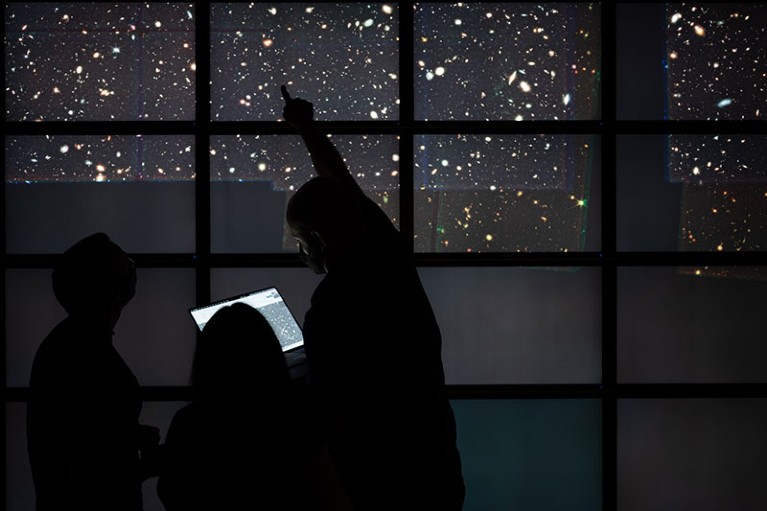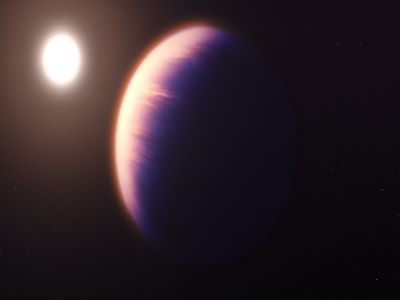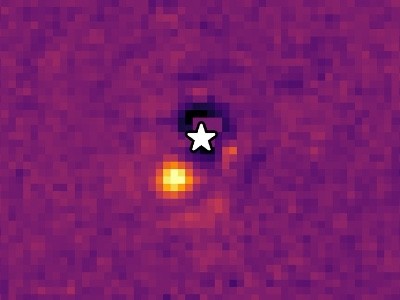[ad_1]

Astronomers have been poring over early data from the James Webb Space Telescope.Credit: Nolan Zunk/University of Texas at Austin
Astronomers have been so keen to use the new James Webb Space Telescope that some have got a little ahead of themselves. Many started analysing Webb data right after the first batch was released, on 14 July, and quickly posted their results on preprint servers — but are now having to revise them. The telescope’s detectors had not been calibrated thoroughly when the first data were made available, and that fact slipped past some astronomers in their excitement.
The revisions don’t so far appear to substantially change many of the exciting early results, such as the discovery of a number of candidates for the most distant galaxy ever spotted. But the ongoing calibration process is forcing astronomers to reckon with the limitations of early data from Webb.
Four revelations from the Webb telescope about distant galaxies
Figuring out how to redo the work is “thorny and annoying”, says Marco Castellano, an astronomer at the Italian National Institute of Astrophysics in Rome. “There’s been a lot of frustration,” says Garth Illingworth, an astronomer at the University of California, Santa Cruz. “I don’t think anybody really expected this to be as big of an issue as it’s becoming,” adds Guido Roberts-Borsani, an astronomer at the University of California, Los Angeles.
Calibration is particularly challenging for projects that require precise measurements of the brightness of astronomical objects, such as faint, faraway galaxies. For several weeks, some astronomers have been cobbling together workarounds so that they can continue their analyses1. The next official round of updates to Webb’s calibrations are expected in the coming weeks from the Space Telescope Science Institute (STScI) in Baltimore, Maryland, which operates the telescope. Those updates should shrink the error bars on the telescope’s calibrations from the tens of percentage points that have been bedevilling astronomers in some areas, down to just a few percentage points. And data accuracy will continue to improve as calibration efforts proceed over the coming months.

This is the first scientific image released from the Webb telescope publicly, on 11 July, showing a deep-field look at the sky that includes a number of distant galaxies.Credit: NASA, ESA, CSA, STScI
The STScI made it clear that the initial calibrations to the telescope were rough, says Jane Rigby, operations project scientist for Webb at NASA’s Goddard Space Flight Center in Greenbelt, Maryland. Much of the issue stems from the fact that Webb, which launched in December 2021, is a new telescope whose details are still being worked out. “It’s been a long time since the community has had a brand-new telescope in space — a big one with these amazingly transformative powers,” Rigby says.
“We knew it wasn’t going to be perfect right out of the box,” says Martha Boyer, an astronomer at the STScI who is helping to lead the calibration efforts2.
Calibration controversy
All telescopes need to be calibrated. This is usually done by observing a well-understood star such as Vega, a prominent star in the night sky. Astronomers look at the data being collected by the telescope’s various instruments — such as the brightness of the star in different wavelengths of light — and compare them with measurements of the same star from other telescopes and of laboratory standards.
Webb telescope spots CO2 on exoplanet for first time: what it means for finding alien life
Working with Webb data involves several types of calibration, but the current controversy is around one of the telescope’s main instruments, its Near Infrared Camera (NIRCam). In the six months after Webb launched, STScI researchers worked to calibrate NIRCam. But given the demands on Webb, they had only enough time to point it at one or two calibration stars, and to take data using just one of NIRCam’s ten detectors. They then estimated the calibrations for the other nine detectors. “That’s where there was a problem,” Boyer says. “Each detector will be a little bit different.”
Within days of the first Webb data release, non-peer-reviewed papers began appearing on the arXiv preprint server, reporting multiple candidates for the most distant galaxy ever recorded. These studies relied on the brightness of distant objects, measured with Webb at various wavelengths. Then, on 29 July, the STScI released an updated set of calibrations that were substantially different from what astronomers had been working with.
“This caused a little bit of panic,” says Nathan Adams, an astronomer at the University of Manchester, UK, who, along with his colleagues, pointed out the problem in a 9 August update to a preprint they had posted in late July3. “For those including myself who had written a paper within the first two weeks, it was a bit of — ‘Oh no, is everything that we’ve done wrong, does it all need to go in the bin?’”
A young observatory
To try to standardize all the measurements, the STScI is working through a detailed plan to point Webb at several types of well-understood star, and observe them with every detector in every mode for every instrument on the telescope4. “It just takes a while,” says Karl Gordon, an astronomer at the STScI who helps lead the effort.
Link: Webb telescope wows with first image of an exoplanet
In the meantime, astronomers have been reworking manuscripts that describe distant galaxies on the basis of Webb data. “Everyone’s gone back over and had a second look, and it’s not as bad as we thought,” Adams says. Many of the most exciting distant-galaxy candidates still seem to be at or near the distance originally estimated. But other preliminary studies, such as those that draw conclusions about the early Universe by comparing large numbers of faint galaxies, might not stand the test of time. Other fields of research, such as planetary studies, are not affected as much because they depend less on these preliminary brightness measurements.
“We’ve come to realize how much this data processing is an ongoing and developing situation, just because the observatory is so new and so young,” says Gabriel Brammer, an astronomer at the University of Copenhagen who has been developing Webb calibrations independent of the STScI.
In the long run, astronomers are sure to sort out the calibration and become more confident in their conclusions. But for now, Boyer says, “I would tell people to proceed with caution — whatever results they might be getting today might not be quite right in six months, when we have more information. It’s just sort of, ‘Proceed at your own risk.’”
[ad_2]
Source link




